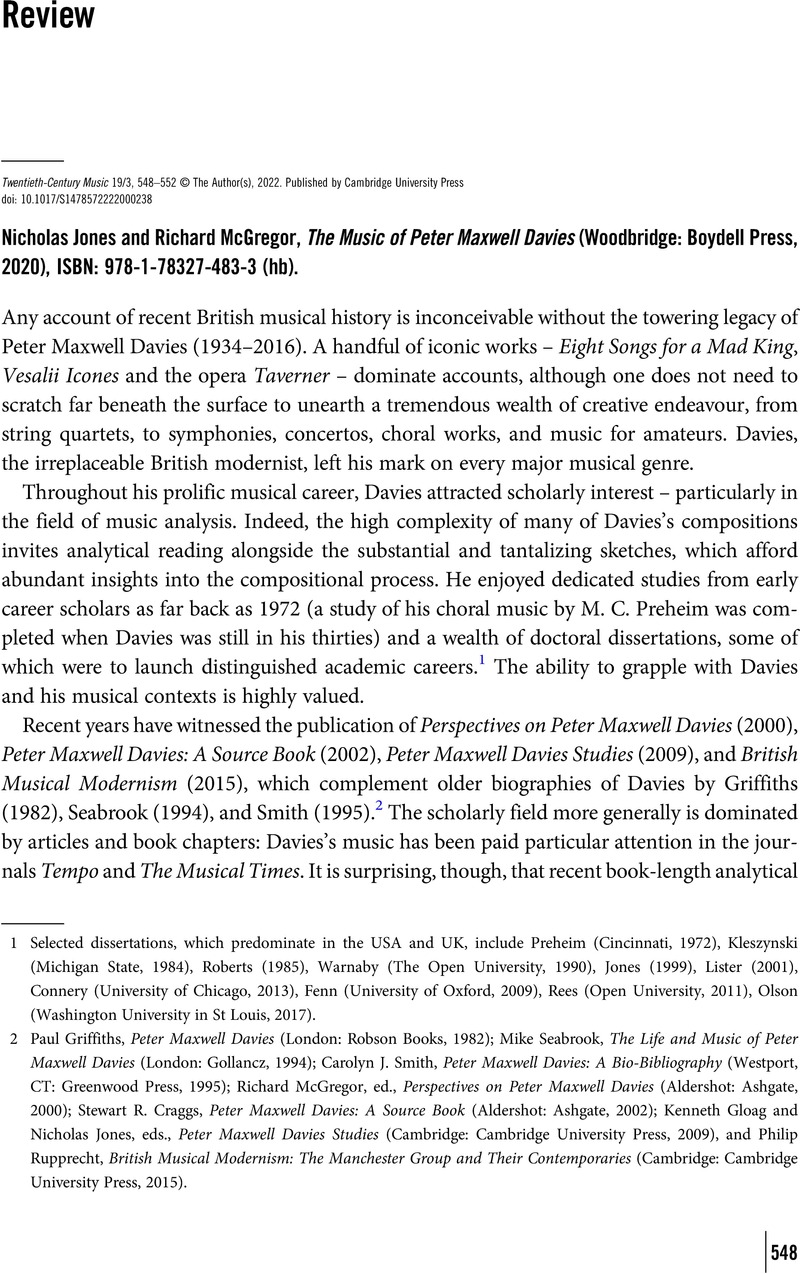No CrossRef data available.
Published online by Cambridge University Press: 05 September 2022

1 Selected dissertations, which predominate in the USA and UK, include Preheim (Cincinnati, 1972), Kleszynski (Michigan State, 1984), Roberts (1985), Warnaby (The Open University, 1990), Jones (1999), Lister (2001), Connery (University of Chicago, 2013), Fenn (University of Oxford, 2009), Rees (Open University, 2011), Olson (Washington University in St Louis, 2017).
2 Griffiths, Paul, Peter Maxwell Davies (London: Robson Books, 1982)Google Scholar; Seabrook, Mike, The Life and Music of Peter Maxwell Davies (London: Gollancz, 1994)Google Scholar; Smith, Carolyn J., Peter Maxwell Davies: A Bio-Bibliography (Westport, CT: Greenwood Press, 1995)Google Scholar; McGregor, Richard, ed., Perspectives on Peter Maxwell Davies (Aldershot: Ashgate, 2000)Google Scholar; Stewart R. Craggs, Peter Maxwell Davies: A Source Book (Aldershot: Ashgate, 2002); Kenneth Gloag and Nicholas Jones, eds., Peter Maxwell Davies Studies (Cambridge: Cambridge University Press, 2009), and Philip Rupprecht, British Musical Modernism: The Manchester Group and Their Contemporaries (Cambridge: Cambridge University Press, 2015).
3 They rather jab, though, about an ‘imposed word count’ prohibiting the text from further comprehensiveness.
4 Dedicated to the memory of Kenneth Gloag, it also includes his valuable insights.
5 Jones, Nicholas, Peter Maxwell Davies, Selected Writings (Cambridge: Cambridge University Press, 2017)Google Scholar.
6 Tom Service, ‘Peter Maxwell Davies at 80: “The music knows things that I don't”’, The Guardian, 19 August 2014, www.theguardian.com/music/2014/aug/19/peter-maxwell-davies-at-80-interview.
7 Located in Jones's first chapter on Davies's ‘biography, stylistic development, autobiography’.
8 These periods contract with Jones's approach in Selected Writings, which describes Davies's music in three periods: from Manchester to Hoy, 1934–70; from Hoy to Sanday, 1971–97; and Sanday, 1998–2016.
9 ‘technique should come from an exhaustive analysis of the music of not only the greatest composers, but as many of the others as he can manage’. The Score, 15 (March 1956), 84–5 reprinted in Jones (ed.), Selected Writings, 21.
10 Jones (ed.), Selected Writings, 102.
11 These sources receive a footnote on page 54. In his note of April 2000, ‘A Composer's Point of View (I): On Music, Mathematics and Magic Squares’, he writes that three texts have ‘for ever influenced my thinking’.
12 An excellent overview of the Classical Music Subsidy is provided by Inglis, Brian, ‘Classical Music, Copyright, and Collecting Societies’, in The Classical Music Industry, ed., Chris Dromey and Julia Haferkorn (Abingdon: Routledge, 2018), 7–31CrossRefGoogle Scholar.